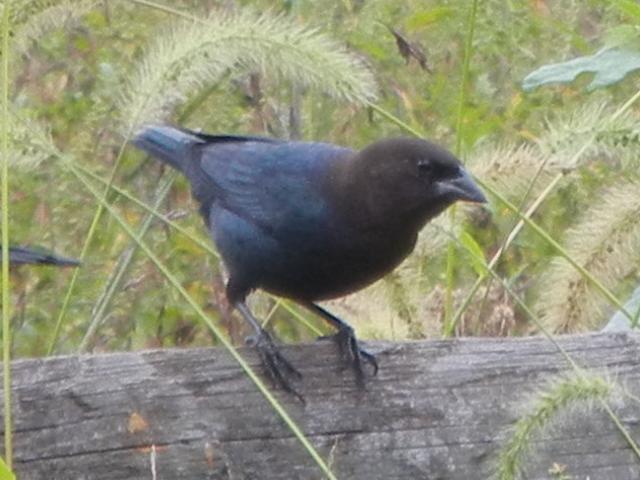Brown-headed Cowbird, Male

Sep 27th, 2011, by Alex Zorach
This male brown-headed cowbird was perched on a fence at Bartram's Gardens in Philadelphia. It was part of a modest-sized flock of cowbirds, mostly male with a few females. The tail of a second male cowbird is visible in the left of this photo. I also took a photo of six of these cowbirds sitting on the same fence.
This bird is distinctive and generally quite easy to identify. Nonetheless, there are several notable features illustrated by this photo. The combination of glossy black plumage with the exception of a dark brown head is distinctive. The brown-headed cowbird has a body shape and build much like other New-world blackbirds (family Icteridae), but has a distinctive stout bill, more like a sparrow or grosbeak; other new-world blackbirds have longer and thinner bills, and Starlings, which are very similar in size, have a long, sharply pointed bill, which helps to easily distinguish these birds in poor lighting. The heavy bill is adapted for cracking seeds of considerable size, reflecting this bird's diet, which is more seed-heavy than other blackbirds.
The cowbird also has a short tail relative to other similarly-structured blackbirds. The black plumage of the male cowbird is slightly iridescent, but much less so than on a common grackle. Note also the black eye; although this field mark is not important in most of this bird's range, the shiny cowbird overlaps with the southern portion of this bird's range, and that bird has a red iris.
Cowbirds are highly gregarious and have a strong tendency to flock. In the mid-atlantic in winter, they frequently join mixed flocks of blackbirds, usually with Common grackles and Red-winged blackbirds; this makes them the smallest member of these flocks. Slightly less commonly, but still often, they also join flocks of common starlings. These birds are best-known for being nest parasites, birds that lay their eggs in other birds' nests. Although native to North America, their range has expanded greatly due to human influences, and they threaten populations of many small birds, including many warbler species.